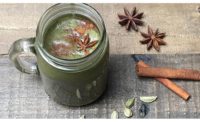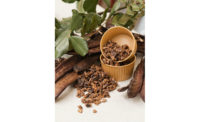2020 PREDICTIONS: BOTANICALS
Plant-Based Trends Are Growing Wild
Botanical Futures: Consumers seek natural answers to everything from everyday health and wellness maintenance to preventing serious conditions

For botanicals, purity and efficacy are paramount, with clean, solvent-free extraction increasingly important to consumers.
PHOTO COURTESY OF: Blue California Ingredients, Inc. (www.bluecal-ingredients.com)
With the plant-based movement currently booming, both new botanicals and those that have long been used in foods or beverages are finding new market avenues and applications.
Botanical sources of nutraceuticals for foods and beverages were already trending up when the plant-based movement kicked into overdrive. This injected a burst of energy into the research and verification of traditional botanical remedies for health and bringing them into foods and beverages.
Consumers are eagerly seeking natural answers to everything from everyday health and wellness maintenance to preventing and even mitigating more serious conditions. This means product developers working with botanicals must walk a fine line between offering consumers what they demand and not promoting unverified claims for a particular ingredient or product. The “Generally Recognized as Safe” (GRAS) status is important, but scientific support for traditional and anecdotal evidence of efficacy is more critical.

Check out our December 2019 issue for more food & beverage predictions!
Certain botanical ingredients, ancient and rediscovered as well as newly discovered are making their way into the better-for-you product toolbox every year. Recent expansion in the field has been in the category of digestive health, in part due to a popular heartburn drug being recalled earlier this year.
Although the emphasis until now has been on other areas of digestive health, such as building the microbiome or addressing certain digestive conditions, heartburn has been largely ignored. It is estimated at about 40% of US adults experience heartburn at least once a month, and 10% experience it daily, and the numbers are only increasing. The recent loss of this leading over-the-counter medicine will result in an uptick of product introductions in dietary supplements that will move over to functional foods.
This means that fulfilling this unmet need is a large market opportunity, as it represents a common health concern for many Americans. Fortunately, a group of well-studied botanicals exists that could be used by those product makers racing to fill this need.
Digestive Aids
Fenugreek (Trigonella foenum-graecum), a culinary spice popular in many South and Central Asian cuisines, has a long history of use in traditional medicine. It has been used for centuries to promote better digestion, healthy blood sugar, and even for increasing breastmilk production. These uses have all been supported through modern scientific methods. In one double-blind clinical study, a standardized fenugreek extract proved to be more effective than a placebo, and was as effective as a commonly used over-the-counter antacid.
Extracts of artichoke leaf and flower bud also are known to stimulate the whole digestive process and also have shown benefits for overall cardiovascular health and for general metabolism. For example, in a multicenter randomized double-blind study, six weeks of treatment with artichoke leaf extract resulted in significant improvements in functional dyspepsia. Interestingly, the results also revealed higher global quality-of-life scores.
Big Mushrooms
Mushrooms have been popular for a while, but in recent years their scientifically-backed extracts have been driving strong interest in the nutraceutical food and beverage channel. Beta-glucan extracts, often derived from reishi mushrooms (Ganoderma lucidum) have gained strong attention for immunity support. Increasingly popular reishi tea is an example of their common use. Coming up, organic wild-crafted chaga mushroom (Inonotus obliquus) extract is appearing in products promoting immunity support, anti-allergenic claims, and anti-inflammatory capacity. On the edible side, porcini and oyster mushrooms are sources of ergothioneine, a natural amino acid believed to hold promise as longevity supplement. One theory of how it works is that ergothionene from mushrooms somehow lowers the risk of developing neurodegenerative disease. Research continues to uncover the benefits of these and other fungi.
Microalgae can be considered the smallest of botanicals — mere single cells — and astaxanthin, derived from the Haematococcus pluvialis algae, has been in the spotlight in recent years as the best-known botanical ingredient in the category. Astaxanthin is a blood-red carotenoid pigment known as a powerful antioxidant. It also has a fairly unique characteristic in that it never becomes a pro-oxidant in the body (unlike many other antioxidants).
Astaxanthin has had GRAS status for more than a decade and has been popular primarily for its benefits to skin and eye health. Later studies have shown it to be an effective ingredient to relieve pain and inflammation, and even for fighting fatigue and promoting detoxification. However, it could soon find a spot in the digestive health toolbox as it was also found to be effective for functional dyspepsia. In a randomized double-blind controlled study, patients reported significant improvements in gastrointestinal reflux over a placebo after taking just 40 mg of astaxanthin daily.
Morning / Night
With new caffeine sources and modulators making their way onto the market, botanicals beyond coffee beans are providing diversification to one of Americas favorite daily rituals: getting charged up for the day. The better-for-you beverage industry is in the initial stages of what could become another key herbal tea: yaupon. Yaupon (with the unfortunate taxonomy Ilex vomitoria) is the only caffeine-containing plant native to North America. It has a traditional use as a beverage tea by both Native Americans and settlers.
Native to regions of the South and Southwest, yaupon is also used as an ornamental landscape plant. Yaupon is starting to show up in small specialty coffee and tea stores across the country, supplied by small start-ups. “Yaupon tastes great and provides a clean pick-me-up,” reports Abianne Falla, of CatSpring Yaupon by Yaupon Holly Tea, LLC. It is similar to green tea in flavor, with some similarities to yerba maté. However, yaupon tea produced here is sustainable, wild, and its American sourcing “benefits our country and increases the value of our biodiversity,” adds Falla.
To complement the pick-me-ups in our routine, sleep support ingredients to help people unwind at the end of their day are also booming. Two notable botanicals promising a bright future are Roman chamomile (Chamaemelum nobile) and saffron (Crocus sativus). Normally relegated to status as “the other chamomile,” Roman chamomile has never been as popular on the markets as the most popular chamomile, German chamomile (Matricaria chamomilla). However, new research is giving this relaxing botanical momentum.
A 2017 study found Roman chamomile to significantly improve sleep quality in elderly people, and results of a 2018 study showed it to have muscle-relaxing activity and an ability to promote healthy cytokine balance. Cytokines are proteins that contribute to cellular signaling and play an important role in the endocrine system the inflammatory processes, and immunity. A clinical study providing further evidence for sleep support is scheduled to be published soon.
Considered the “most valuable spice,” saffron has long lent allure to cuisine, giving dishes a more gourmet identity. But recent clinical studies show that saffron extracts promote healthy mood, decrease stress, and improve sleep. This is driving consideration of saffron as an ingredient beyond its gourmet identity and focusing on its better-for-you functionality.
With the sales of plant-based foods up 20% year-over-year, some say that the plant-based diet trend is here to stay. Combined with the “adventurous consumer” trend, opportunities for new botanical products will continue to abound for the foreseeable future.
Looking for a reprint of this article?
From high-res PDFs to custom plaques, order your copy today!






